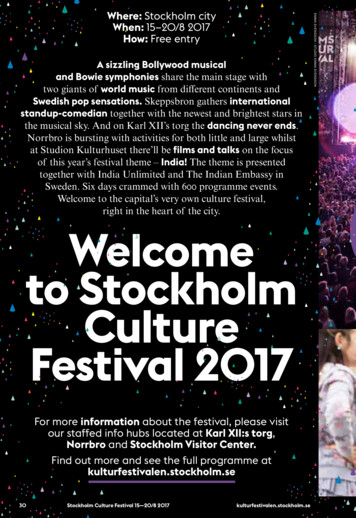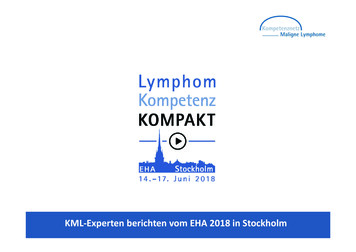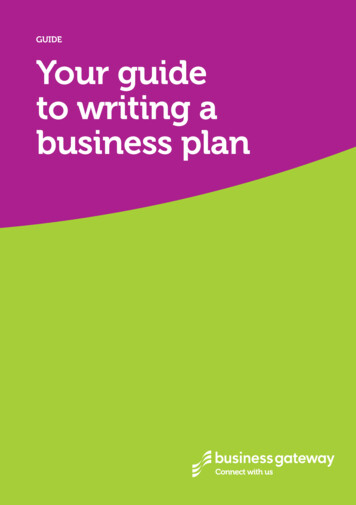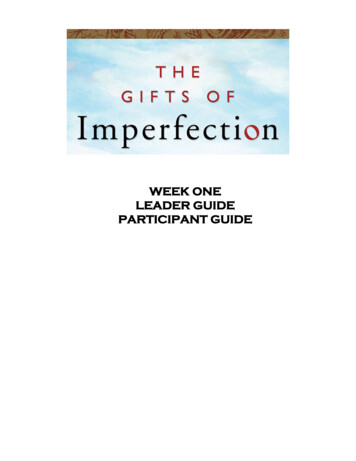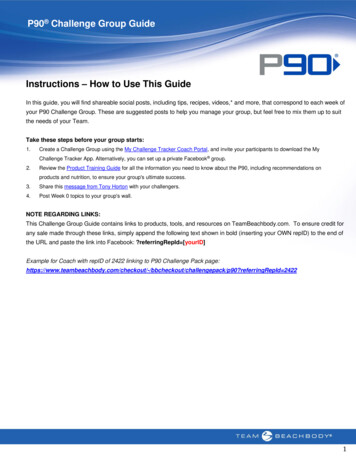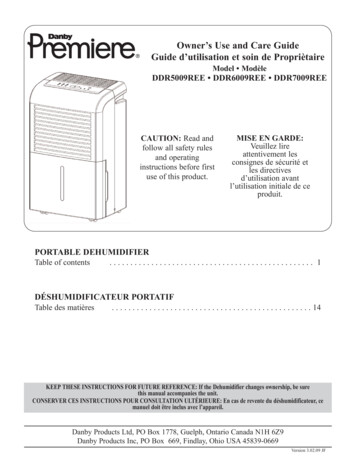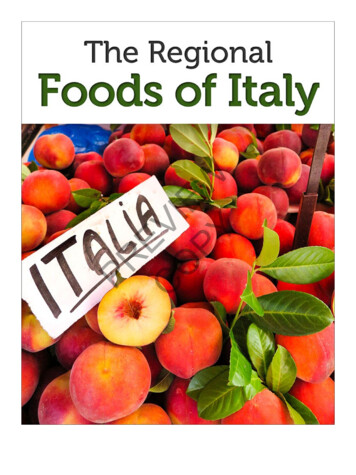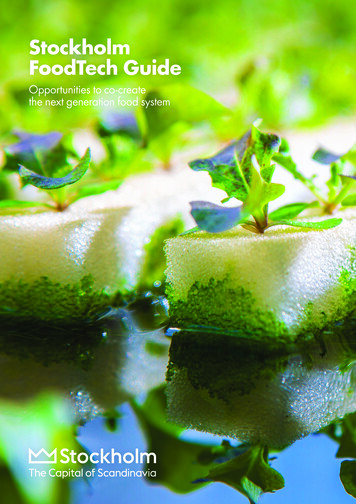
Transcription
StockholmFoodTech GuideOpportunities to co-createthe next generation food system
2Ready to explore theStockholm FoodTech scene?When Stockholm was first mentioned as a FoodTech hub back in 2018, the citywas already riding a wave of rising FoodTech activities, all aimed at remodelingthe world of food into something healthy and sustainable.The drive towards a rapid shift of the food system has been further increasedbecause of the pandemic, with a rapidly increasing focus on food waste, foodsupply chains and food security. The future of food will happen in places wherehealth and sustainability are core, where tech and data are mature industries, andwhere conscious consumers and policymakers actively look for new solutions.For this important but specialist interest in creating a next generation food system tosucceed, there has to be a unified common interest behind it. As such the focus ofthis guide is not only on the investors and entrepreneurs, but also the other ecosystemplayers contributing with their own cogs in the larger machine that is crankingout ever better food solutions, be they research or tangible services. All are badlyneeded in order to meet the UN’s SDGs.Together we can solve these challenges and develop new and exciting solutions.That is why with great pride we can state that everybody in this magic city under thenorthern skies is ready to welcome you to co-create the truly sustainable food system,with all the products and services it entails. If you’re an investor, the opportunitiesare massive. If you’re an entrepreneur you won’t only find talent and investors, butalso ready and willing consumers. If you’re a big food company, it’s time to startengaging with the dynamic innovation system coming out of Stockholm. If you’rea talent, simply come and be sucked into the most magic FoodTech hub on planetEarth!Welcome to Stockholm!Stockholm, November 2021Anna GisslerCEO, Invest StockholmJohan JörgensenPartner, Sweden Foodtech
3“As a Mayor of Stockholm I put climate, life quality and sustainable food consumptionat the heart of the political agenda. In schools, elderly care homes and kindergartensof Stockholm hundreds of thousands of public meals are served every day. It givesthe city a great opportunity to influence and develop the entire urban food valuechain. Stockholm is taking new strong actions to make the vision of Future GoodFood City happen. Our vision is that Stockholm becomes one of the most sustainable,creative and innovation-driven gastronomic capitals of the world as well as the bestplayground for business and science to explore and co-create the next generationfood system.PHOTO: HENRIK TRYGGAnna König Jerlmyr Mayor of Stockholmn
4ContentsExecutive SummaryWhy FoodTech in StockholmTap into the Swedish MarketStockholm FoodTech PlaygroundThe Vibrant FoodTech Investment LandscapeFuture Outlook and OpportunitiesThinking of Starting Up in StockholmResponsible for the guide:Jenny Berthling, Invest StockholmOleksandra Kovbasko, Sweden Foodtech
5Executive SummaryFoodTech is the intersection of food and technology: the applicationand use of technology to improve agriculture and food production,supply chains, the distribution channels and ultimately consumption.From companies using science to improve the yields or compositionof produce, to businesses working on reducing time to market andsimplifying the supply chain, through to the online marketplaces,delivery services and in-house gadgets in the hands of the consumers– Stockholm has it all.This guide begins with a presentation of the Stockholm food scenefrom different perspectives: from Stockholm being the gastronomicalepicentre of the Nordics to tech innovations and progressivesustainable values. In combination these form a solid bedrock forStockholm to strive to be the international playground for the nextgeneration food system.The guide also encapsulates the latest investment statistics, trends, andchanges in the FoodTech scene in Stockholm. Swedish startups have1raised a total of 421 Min 20 which is the highest amount in theNordics. Most of this funding has landed in Stockholm.Reecting the sector’s growing importance, this edition of theStockholm FoodTech Guide includes a mapping of over 130 startupsand key players in the industry and analysis of investment ows. Inaddition, a number of FoodTech stories are told in order to representthe diverse nature of the Stockholm FoodTech ecosystem and theindividuals that are the key contributors to our thriving FoodTech scene.Stockholm is dened by its spirit of constant collaboration, opennessand innovation, so we nish by outlining the vision to positionStockholm as a Good Food City, the international playground forexploring and co-creating the next generation food system.PHOTO: SHUTTERSTOCK1. Startup Heatmap / Crunchbase
6Why FoodTech in StockholmStockholm is the capital of Sweden, a country thathas proven successful in fostering innovation andentrepreneurship. A strong social security systemand abundant governmental funding help de-riskthe starting of a business, while generous parentalleave for both women and men and affordablechildcare ensure women have an opportunity tostay in the workforce.modern concept restaurants, innovative kitchensand Michelin-starred restaurants.The World Economic Forum ranks Sweden as oneof the top ten most competitive countries in theworld, with top grades for innovation capacity.World-class universities such as the KarolinskaInstitute, Royal Institute of Technology andStockholm School of Economics deliver high calibertalents to ambitious enterprises, while at the sametime doing important R&D and commercializingresearch. The Swedish Government offers a numberof tax incentives to stimulate research in the countryin collaboration with universities.The range of modern gourmet restaurants inStockholm is astounding, and the taste adventuresrank very well in competition with any othercity in the world. Proof of that came in 2021when Frantzén was named the world’s sixth bestrestaurant2.Stockholm has some of the world’s best foodscenes, with creative chefs who all share aninnovative approach to Scandinavian culinarytradition, and with a focus on carefully selectedproduce plus locally produced organic goods.PHOTO: FRANTZÉNHighly respected in tech circles as a hub ofentrepreneurial activity, Stockholm is second onlyto Silicon Valley in producing unicorns – billiondollar, venture-capital-backed companies – percapita. The city is the perfect sandbox to build yourproduct, test product-market fit and expand acrossEurope or the US.Who would have thought that a country coveredin snow for several months of the year, where frostlimits the number of harvests, and famed for the(according to some) outrageous habit of eatingfermented herring, could ever play a leading rolein changing the global food sector?A Gastronomical StockholmSweden with capital city Stockholm at the forefronthas undergone many ground-breaking changesduring the past few decades when it comes toits culinary scene. A number of local chefs havetransformed Stockholm into a world-renowneddestination for food tourism, world-class cuisine,Another guide weighing in on both gastronomyand sustainability is 360 EAT GUIDE Nordic,where Oaxen is at the top and many otherStockholm restaurants are included: Gastrologik,Fotografiska, Aira, Agrikultur, Petri, Portal,Rutabaga, Oxenstiernan, Paul Taylor, Adam/Albin,Etoile, Ichi, Matbaren and Hantverket.But the food scene is not only at the domain of topchefs – the entire food sector has been boostedby a number of new entrepreneurs setting uprestaurants, shops, food trucks and servicesaround food, proving that a new and more diverseapproach to food appeals to the modern citydweller.2. The award is presented by William Reed Business Media and is based on a voice process from over 1,000 restaurant owners, chefs and food writers worldwide.www.theworlds50best.com/list/1-50
7A smorgasbord of stats and info regarding the delicious food scene in StockholmInfluences from all over theworld create a constantlyevolving smorgasbord ofdiverse taste sensations5 high tech urban farmsestablished inStockholm’s city centreRESTAURANT5 700 restaurantsGOOD FOOD CITY1 200 Nobel Prize banquetdinners served every yearNothing explains "fika"better than a cup of coffeeand a cinnamon bun6 Sustainable-starredrestaurants and10 Michelin-starredrestaurants awardedwith 15 starts total300 innovative techcompanies make Stockholmone of Europe's strongest hubsfor sustainable food systemsMUSEUMEach Swede drinks1 095 cups of coffeeevery yearMany of Stockholm'smuseums have greatrestaurants and cafés8 tours to explorethe food sceneSource: Visit StockholmMichelin-starred restaurants in StockholmFrantzénOaxen KrogAgrikulturGastrologikSushi ShoAloëEkstedtOperakällarenEtoileAIRAIn addition to the star awards, Guide Michelin launched a new sustainability label in February 2020. Restaurants that are at the forefrontof sustainable gastronomy are recognized with a new, green symbol. In Stockholm, no less than six restaurants are celebrated: Agrikultur,Etoile, Fotografiska, Gastrologik and Oaxen Krog and Oaxen Slip.
8A progressive, innovative and sustainable food sectorBeing a bottom-up movement, The New NordicCuisine started with a group of food aficionadosand chefs who had a love of Nordic food. They setup a manifesto underlining not only the importanceof wholesome green ingredients and sustainablefarming methods, but also stressing the overallsocial responsibility of the food industry. NewNordic Cuisine takes Scandinavian culinarytradition to a new level in an innovative version,using carefully selected ingredients and focusingon locally produced, organic foods. Stockholm isat the forefront when it comes to sustainability andclimate friendly solutions, and the New Nordicmovement follows that spirit, aiming to weave goodfood into all aspects of society.Food is much more than what is on your plate; itencompasses the entire system bringing it to thatvery plate, and also involves taking care of thewaste left after the food has been consumed.Food is also the last major sector set to befundamentally transformed by the internet,technology, and the digital transformation theybring along. The next revolution in the food sectoris about to happen through new value chains,business models and food products, putting theemphasis on health and sustainability while givingthe current status a total makeover.The Swedish capital’s leading position is partly dueto the fact that we have already grown used to anext generation food system, one driven by techand data, and geared towards the healthy andsustainable solutions that will be needed to feed thesoon-to-be nine billion people on the planet. Foodis a huge system that concerns every single personon earth and, as a system, contributes some 30percent of total global greenhouse gas emissions.Making sure that this huge system is sustainable istherefore a sizeable challenge.As the fastest-growing city in Europe, with apopulation expected to grow around 10 percent by2030, Stockholm is potentially a unique testbed fornew systems aimed at growing food in cities andintegrating these new food distribution systems intourban development. The drive towards a quick shiftof the food system has furthermore been increasedbecause of the pandemic, with a rapidly increasingfocus on food waste, food supply chains and foodsecurity. This has also been reflected in the starkincrease in the amount of funding for the startupscurrently focused at the latter stages of the supplychain: e-Grocery and last mile delivery.
9Food is much more than what is on yourplate; it encompasses the entire systembringing it to that very plate, and alsoinvolves taking care of the waste left afterthe food has been consumed.PHOTO: JOHNÉR
10Stockholm – The Unreal Real Deal0103Culinary HubWith its focus on ethical, quality, healthy andsustainable food, The Nordic Kitchen is a globalfood revolution (www.newnordicfood.org) andStockholm is at its forefront. With a philosophythat moves beyond simply producing good foodand instead also focuses on culinary experiencesas a whole, a number of Stockholm chefs areleading the charge in the area by transformingthe city’s food scene to make it a world-renowneddestination for food tourism. Both the city andSweden as a whole have seen their food scenesgain a significant boost as a result, and in linewith Stockholm’s spirit of innovation, this is not theexclusive domain of a few top chefs. A numberof new entrepreneurs have had a major impact,setting up new restaurants, shops, food trucks,and food services. They continue to demonstratethat innovative ways of producing food appealto modern city goers, who are not only enjoyingeating the city’s innovations, but talking about ittoo!Health ConsciousIt is impossible to think about food withoutalso thinking about health, either positive ornegative. Healthcare is the planet’s second largesteconomic system, representing nine percent ofglobal GDP, and in order to provide healthcareto all we must become healthier overall.Stockholm’s very health-minded population isa strength here: the strong Swedish healthcaresystem, spearheaded by the Karolinska InstitutetUniversity Hospital in Stockholm, and a strongresearch community combined with dynamicpharmaceutical and MedTech sectors havecreated a unique opportunity to bring about newfood-based health solutions, using the combinedexpertise of the food and healthcare industries.02Environmentally AwareWhen it comes to environmental awareness, fewplaces beat Stockholm. With Sweden repeatedlycompeting for top spot in Yale University’sEnvironmental Performance Index, Stockholm leadsthe way for the country at large. The days whencaring for the environment was nothing more thana must-have line in CSR reports are long over – theenvironment is now a real priority. The fact thatStockholm Resilience Center has established itselfas one of the planet’s foremost research centres onenvironmental issues is proof ot that commitment.04Pursuing ProgressStockholm is a city that constantly strives forchange. Its citizens love nothing more than tryingnew things, and progress is considered the key toa fulfilling life. It’s no coincidence that many largemultinational corporations have chosen Stockholmas a testbed for new products and services. If itcatches on in Stockholm, the chances are good thatothers will eventually follow. For those interestedin new trends for products and services in the foodsector, Stockholm is the place to watch. And if youwant to try out new things, Stockholm is the placeto be.05The World-RenownedStockholm Tech SectorStockholm has long been established as one ofthe world’s strongest, most vibrant tech hubs, andits lengthy list of international tech success storiescontinues to grow. The deep tradition of innovationand dynamism in the tech sphere means Stockholmis home to many unicorns (startup companies
11“If you are interested in new trends for products and services in the food sector, Stockholmis a place to watch. If you want to try out new things, Stockholm is the place to be.05Carolina Sachs Partner, Martas Explorerscontinuedvalued at USD 1 billion), including Spotify, Klarna,Skype, Mojang, King, iZettle, and Bambora.The Swedish capital also serves as the keygateway to other countries in the Nordic region,and an excellent hub for operating throughoutEurope. The most common job title in Stockholm?Programmer. Students meanwhile are most likelyto cite becoming an entrepreneur as their careerplan when graduating university. Neither is acoincidence.06One of Europe’s Leading InvestorCommunitiesNot only boasting some of Europe’s leadingventure capital firms, a wide range of active angelinvestors and family offices also call Stockholmhome. This position as a leading financial hubas well as the host for the global headquarters ofmany large multinational corporations also meansentrepreneurs have easy access to a wide-rangingexpertise on capital and international business inStockholm.07Fantastic Meeting SpotsBoth the regional and global tech sector host anumber of major conferences and arenas in thecity, with annual FoodTech events in Stockholmincluding Sweden Foodtech Big Meet and EATForum, the global food policy event founded byGunhild Stordalen. Both are linked with one ofthe world’s largest annual restaurant and foodfestivals, Smaka på Stockholm (Smaka GoodFood Festival), which gathers 350,000 peopleat Kungsträdgården in Stockholm’s city centre fora week of talks, tastings and networking. Theseare but some of the incredible FoodTech eventsoccurring throughout the year, with organizationslike Open Labs and Matlust playing a prominentrole.08Innovation GrantsBoth Swedish innovation agencies, Tillväxtverket,the Swedish Agency for Economic and RegionalGrowth, and Vinnova, the Swedish InnovationAgency, have programs aimed at entrepreneurs inthe FoodTech sector, effectively providing fundingfor the future of the fast-growing sector.09A Strong Public InterestThe booming Swedish interest in food is muchbroader than one for chefs, restaurants andretailers exclusively. The entirety of Stockholm’secosystem is involved in some way, including thepublic sector, where the Department of Agricultureand its equivalent for the Stockholm region havedeveloped food strategies. Food served in publicsector organizations like schools and hospitalsrepresents 40 percent of all meals served outsideof the home in Sweden, and its focus on locallyproduced, sustainable and healthy food hasearned plaudits. The city of Stockholm is not onlya major buyer of food, it also puts significantresources behind becoming a leading player inurban farming, with several cultivation centresestablished around the city, and an urban foodsystem being at the core of its city planning.10Attitude in SpadesStockholm’s size is one of the city’s strengths,being both big enough to provide scale and smallenough to stay agile. The attitude of the ecosystemis another positive, as a defined spirit of openness,positivity and paying it forward endures regardlessof whether you’re talking to a director of a largeindustrial behemoth or to a fresh programmer.Contacts are quickly made and knowledge shared;ask for help and you’ll get it. Trust your neighbour,and they will trust you.
Sweden has the highest concentration of LOHAS(Lifestyles of Health and Sustainability) consumers globally.LOHAS goes beyond organic or local; consumers care aboutwhere and how the ingredients are grown, sourced, their impacton biodiversity and the environment, worker conditions, packagingmaterials used and of course whether the product is a healthy one.PHOTO: MASKOT BILDBYRÅ12
13FOUNDER INSIGHT STORY“Sweden is a great place to start a business – it’s easy to network,English is widely spoken and it offers a great life for an expat.Shameek Ghosh CEO and Co-founder, TrustraceTrustrace is a market-leading platform for supply chaintransparency and traceability within Fashion and Retail,that brings transparency to producers who really want toknow what they sell and for consumers who really carewhat they buy.Founded by four IT professionals of Indian origin,Trustrace is helping brands and retailers solve someof the biggest challenges in achieving sustainablesupply chains – the lack of transparency. Sustainabilitycannot be achieved without transparency, as brandsand producers are struggling to understand how tobest change their impact, and consumers are findingit difficult to navigate between greenwashing and truesustainability.The idea came about in 2016 when one of the foundersmoved back to India from Sweden to help his family runan organic farm. It has been passed down from fatherto son for the past 150 years but lately, crops have beennegatively affected by the untreated wastewater from thetextile factories in the area.“We started the project as a hobby initiative. We wantedto collaborate with international companies and put thespotlight on the supply chain, ensuring that these badpractices are discontinued.”Fast forward five years and Trustrace is working withbrands like Filippa K, Fjällräven, Decathlon, Zalandoand COOP. They have traced over 250,000 productsand materials, worked with over 6,000 suppliers andare not stopping.In the past year, Trustrace has doubled its staff. Shameeksays that the pandemic has sharpened consumerawareness and increased the demand for sustainableproducts. After all, Sweden has the highest concentrationof LOHAS (Lifestyles of Health and Sustainability)consumers globally – 40% of Swedes make shoppingdecisions based on these values. LOHAS goes beyondorganic or local; consumers care about where and howthe ingredients are grown, sourced, their impact onbiodiversity and the environment, worker conditions,packaging materials used and of course whether theproduct is a healthy one. LOHAS consumers are waymore likely to read the list of ingredients and the fineprint. And that’s where Trustrace is helping brands toknow more about their suppliers and communicate itto the consumers.This is a win-win-win. For the company (59% of Swedesare ready to pay more for sustainable products), forconsumers, and for the planet.Shameek says it’s a global trend:“The EU’s greensustainability program has sent ripple effects aroundthe world, reaching the boardrooms and making morecompanies aware of the importance of reducing waste inthe food supply chain. It is a really big leap forward forFoodTech and also for sustainable production.”Shameek moved to Sweden from India for a corporatejob. When it came to starting a business, he waschoosing between the UK, Sweden and France.Stockholm won because of ease of doing business, thelargely English-speaking ecosystem and the quality of lifefor expats.Another big factor that works to Stockholm’s advantageis a collaborative culture within the entrepreneurialecosystem. “Trust plays an important role here andyou can build a lot of value-based relationships. Peoplerespect other people’s valuable time and do not waste it.There is a common understanding around this fact,” saysShameek.With a population of about a million inhabitants,everyone is only two handshakes away: “It’s easy tonetwork, you easily can get access to technology, capitaland people. Serial entrepreneurs and investors find thetime to mentor and advise early-stage companies.”“The best part of living here is that healthcare andschooling are free for my children. It is a great benefitthat Sweden provides. People are open and there is aninherent trust in this city. I had the chance to live in the UK,France or Sweden and I decided to move to Stockholm.Not only is the culture very accommodating but also theEnglish language is not a problem in my personal life asan English speaking person moving to Sweden. My basicfundamental needs were met in 30 days after moving toStockholm.”
14Tap into the Swedish marketThe Swedish Food Industry in a NutshelSome key numbers make the importance ofSweden’s food industry clear. The third largestindustry in the country, there are 4,600 foodcompanies in the food sector, employing close to55,000 people.Top 10 SDGs – the share of Swedishconsumers that think companiesshould prioritise these SDGsIn 2019, sales of food and drinks reached EUR30.3 billion (305 billion SEK), a 3% increasecompared to 2018 and 103% in growth since2000. While sales in most categories of food anddrinks except ‘milk, cheese and eggs’, and ‘fruits’rose in 2019, the one with the greatest growthis ‘coffee, tea and cocoa’, expanding by 13.6%compared to 2018 (SCB).Market shares and salesPercentage of sales in 201924%31%22%31%19%29%18%25%17%ICA 52.3%Lidl 5.1%Bergendahls 5.3%Coop 18.8%35%The chaincompanies’ totalsales SEK270.3Axfood 18.5%billionThere are five major supermarket chains inSweden with ICA firmly dominating the market(52.3% market share). COOP and AxFood(Hemköp & Willy’s) share second place with18.8% and 18.5% respectively3. So how do youget your product to the supermarket shelves? Wespoke with Sara Maxence, Innovation Lead at ICAabout exactly that (read more at page 17).Swedish consumers express strong preference fora lifestyle of health and sustainability (LOHAS) witheven price being a secondary criteria. To manyof the next generation, the determining factorsare plant-based, seasonal, and less or naturallyprocessed food (Try Swedish initiative). Moreover,Swedes hold great curiosity and openness inembracing new flavors. Many of the classicSwedish dishes were influenced or came fromabroad. The Swedish meatball, of Turkish roots, isthe perfect example of the fusion in tastes4.3. 0103 2019a01 sm rtan-2020/4. hat-to-do/food-drink/swedish-food-culture/5. nable-swedish-consumer-of-2021
15The share of Swedish consumersthat are affected by sustainabilitywhen making a purchasing decision74%For Swedish consumers, the most important SDGthat they would like companies to prioritize is SDG12, Sustainable Production and Consumption(35%). Swedish consumers consider theirpurchasing decisions of food and beverages as thearea where they can have the most impact (42%),followed by selecting energy providers (39%), andbuying electronic products (34%)5.Top 3 most affected areas whenSwedish consumers are makinga purchasing decision42%39%34%When buyingfood &beverageWhen choosingan energycompanyWhen byingwhite goodsor consumerelectronicsSustainability as a mindset or value impactsall spheres of life, from thorough recycling,avoiding single-use plastics, and buying local tochoosing more environmentally friendly modes oftransportation and preferences for second-handclothes. When it comes to purchasing food, wherethe food comes from (65%), nutrient profile (48%),animal welfare and environmental concerns (47%)are the major factors for Swedish consumers.An Introduction to Market Entry to SwedenPHOTO: CAMILLA SJÖDIN LINDQVIST / JOHNÉROnce you have made the decision to expand to theSwedish market, there are many ways to go aboutit. We won’t make an exhaustive list of strategies butwill rather highlight the differences and what we sawworking for the companies adopting that approach.B2B tech companies will enjoy the ease of doingbusiness in English, however, hiring a businessdeveloper with local industry experience and whospeaks Swedish is likely to speed things up.If you represent a product company and you’d like toget to the shelves of the Swedish supermarkets, youhave 2-3 windows of opportunity a year to achievethis. The retailers adhere to the product rangerevision schedule announced by the ECR. July andDecember are the two months when business takes apause for summer and winter vacations respectively.Alternatively, one can first build awareness ofa product through collaboration with chefs andrestaurants and later expand to retail. We’ll look intothis in the next chapter.
16PHOTO: BEYOND MEATPHOTO: HOOKED FOODSPHOTO: EAT JUSTEat Just, Beyond Meat and Hooked Foodsare some of the latest examples of NextGen(next generation) Food & Drinks.Market entry via the hospitality sectorIf the product is very new, it might take someconvincing for consumers to pick it up from theshelf. And as a brand, you’d better either have amassive marketing budget or strong allies amongchefs. Beyond Meat and Eat Just are some ofthe latest examples of ground-breaking productslaunching their next-generation plant-based burgerpatties and cultured chicken nuggets first in highend restaurants and then making their way torestaurant chains and retail.Restaurants were hit hard during the pandemic withtotal sales shrinking by nearly 25%. The chefs thatstayed in business are only getting more creative andopen to new ideas. Startups like Stockeld Dreamerywho aim to create ‘the most ambitious plant-basedcheese’ have extensively collaborated with chefsto refine the taste and texture of their first product‘Stockeld Chunk’ which mimicks feta cheese.Exceptionell Råvara (‘exceptional produce’’ inSwedish) is bringing together the best chefs andproducers in Sweden with the aim of creating along-term platform for the development of rawmaterials and new business opportunities. Chefsare always on the lookout for new ingredients,suppliers that share their values and qualitystandards. Exceptionell Råvara creates aforum where chefs can evaluate the produce,give feedback to the farmers and share theirknowledge.One of the startups that has successfully launchedtheir product through collaboration with restaurantsis Hooked Foods. Hooked has developed‘Toonish’, a plant-based tuna that is packed withnutrients. They have partnered with Hawaii Poke,Mahalo and Misch Masch and since March 2021,Toonish was available on restaurants’ menus. Theproduct got positive feedback from consumers andsix months later has launched in retail stores.Public procurement plays an important role in thefood system, as three million meals are providedat health care, school and care every day. Schoolsreceive almost half of these (1.3 million meals perday), followed by the numbers of meals served at‘preschool’ and ‘leisure’. The good news is thatover half of the meals served in the public sector inStockholm is procured from sustainable sources6.6. ntliga-maltider
17F O O D R E TA I L E R I N S I G H T S T O R Y“Our objective is to accelerate good solutions getting to market faster.We need to reform our food system and we want to be a part of it.Sara Maxence Innovation Manager, ICAICA group holds by far the biggest market sharein grocery ret
dollar, venture-capital-backed companies – per capita. The city is the perfect sandbox to build your product, test product-market fit and expand across Europe or the US. Who would have thought that a country covered in snow for several months of the year, whe
